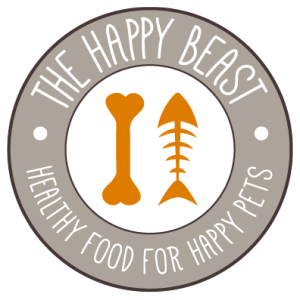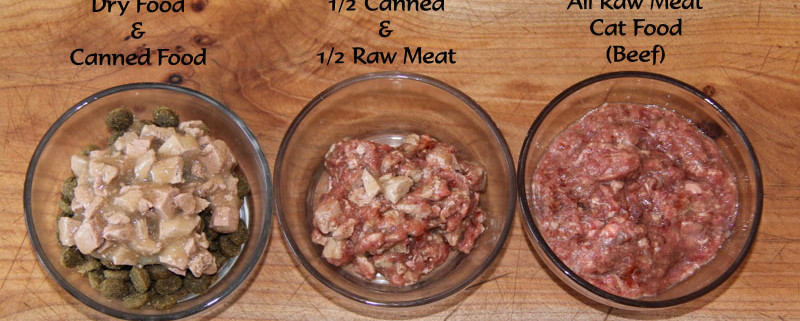What is the Difference Between Raw and Canned Food for Cats?
According to VPI (Veterinary Pet Insurance), gastrointestinal issues are among the top ten reasons cats visit the vet. We feel very strongly that feeding a species-appropriate diet reduces the occurrence of GI issues, saving you money by eliminating treatment by a vet. In a blog post from last month, Dr. Angie Krause stated that she believes the need to see a vet would reduce by 50% if animals were fed a species appropriate diet!
Our ultimate goal is to see our customers (those wonderful cat guardians) get their animals off of dry food and onto a high moisture, high protein, low carbohydrate diet. Most people are familiar with canned foods, but raw foods are still a relatively unknown food option. There are three big differences between Raw and Canned food.
- Raw / Uncooked vs. Cooked (obviously)
- Amount of carbohydrates
- Use of thickening agents (e.g. Guar Gum, Carageenan, etc.)
In this post, we are going to focus on #3, because #1 is a much bigger topic (2.2 million Google Searches for: benefits of raw food diet!) and #2 has previously been discussed in our blog Flimflam Food: The Truth About Grain-Free Pet Food.
Although canned foods are a much more appropriate option for cats than dry food, it is still important to pay attention to the ingredients. Most canned foods still have a higher than ideal carbohydrate count (over 5% carb) and almost all brands utilize a thickening agent such as potato starch, tapioca starch, carrageenan, guar gum, xantham gum, locust bean gum, and agar agar. These additives are used to give the product a certain texture and consistency. Let’s focus on what these thickening agents are and their potential side effects.
- Potato Starch – Extracted from potatoes, used as a thickening agent and does not provide any nutritional benefit. It is very important to pay attention to the amount of starch used as any amount above 5% is too high for a cat.
- Tapioca Starch – Extracted from cassava root, used as a thickening agent. Consists almost entirely of carbohydrates and has no significant amount of essential vitamins or minerals.
- Carrageenan – A polysaccharide extract from red seaweed. It is commonly used as a thickening agent in both human and animal foods. Studies disagree about the effects on the GI tract, but it should be noted that certain studies urge caution because of the belief that it irritates the GI tract by causing inflammation.
- Guar Gum – Fiber from the seed of the guar bean, used as a thickening and stabilizing agent. Side effects include increased gas, diarrhea, and loose stools for digestively sensitive cats. Studies have shown that guar gum inhibits the digestibility of both fat and protein in older cats and those suffering from digestive issues, such as Irritable Bowel Disease (IBD). Read more about IBD on our blog.
- Xantham Gum – Used as a thickening agent and engineered in a laboratory by the US Department of Agriculture in 1969. To date, no studies have been conducted on its effect in cats, however it should be noted that Xanthan gum was identified in 2011 as the cause of a deadly form of colitis responsible for several infant illnesses and deaths.
- Locust Bean Gum – Derived from the seed of the carob tree, it is used as a thickening agent. No studies have been conducted on its digestibility in cats. In human studies, individuals reported similar side effects to guar gum (e.g. increased gas, diarrhea, and loose stools).
- Agar Agar – An indigestible fiber source extracted from red seaweed. In the digestive tract, it absorbs water, increases bulk, and stimulates bowel movements. It has been used for centuries as a laxative. No studies currently exist on its affects on a cat’s digestive tract.
For a healthy cat, these thickening agents might not pose a serious harm to their initial state of health. But because gums, such as Guar Gum reduce digestibility, cats with GI issues are unable to get all the nutrition that they need, and symptoms such as diarrhea may persist due to their potentially inflammatory and laxative properties. Additionally, as cats age, digestive function becomes less efficient and the body has a reduced ability to compensate for less digestible foods.
Cats with IBD, like our foster cats Dottie and Fancy, need to be on an exclusively raw food diet. We have “experimented” with different brands of canned foods, all containing various thickening agents. The results are always the same: loose and excessive stools even when given less than ¼ tsp!
Raw food is our number one option when it comes to cats. Raw food most closely simulates their natural diet of rodents, rabbits, and birds. It is the least processed of all the commercially-available food options and does not contain fillers or thickening agents. Compare the ingredients in a raw diet for cats with those of a canned diet.
- SmallBatch Raw Chicken Formula: 97% Chicken, 1% Produce, 2% Supplements: Chicken, Skinless Chicken Necks, Chicken Backs, Chicken Livers, Chicken Hearts, Chicken Gizzards, Salmon Oil, Organic Dandelion Greens, Organic Apple Cider Vinegar, Organic Kelp, Organic Bee Pollen, Organic Barley Grass, Organic Cranberries
- Mauri Brushtail Canned Food: Brushtail, Brushtail Broth, Pumpkin, Ovine Plasma, Calcium Carbonate, Fish Oil, Locust Bean Gum, Xanthan Gum, Guar Gum, Vitamins & Minerals: (Choline Chloride, Vitamin A Supplement, Vitamin D3 Supplement, Vitamin E Supplement, Vitamin B12 Supplement, Biotin, Sodium Selenite, Folic Acid, Calcium Iodate, Riboflavin Supplement, Pyridoxine Hydrochloride, Thiamine Mononitrate, Copper Amino Acid Chelate, Manganese Amino Acid Chelate, Calcium Pantothenate, Niacin Supplement, Iron Amino Acid Chelate , Zinc Amino Acid Chelate), Cranberries, Taurine, New Zealand Green Mussel.
Raw food is more digestible than cooked food, and especially more digestible than the protein found in kibble. Due to its higher digestibility, raw food is the best option for a cat suffering from GI issues. While feeding your cat raw meat, initially seems odd, when we take the time to consider the fact that cats don’t cook their prey, the concept of raw doesn’t seem so far fetched.
Let’s take a look at the cost to feed both raw and canned foods, I think you will be surprised at the cost (in a good way!) Remember there are lots of variables that can drive up and down the cost, for instance feeding a “novel” protein such as Rabbit or Venison will cost more, but feeding Raw “chubs” (big blocks of meat) will drive your cost down.
COST OF RAW FOOD: 3lbs Bags with 1oz sliders:
- 8 lbs: 160 cal/day: 3oz of raw: $30/month
- 10 lbs: 200 cal/day: 4oz of raw: $40/month
- 12 lbs: 240 cal/day: 5oz of raw: $50/month
- 15 lbs: 300 cal/day: 6oz of raw: $60/month
Cost of Raw Food Chubs (2lb sausage shaped)
- 8 lbs: $18/ month
- 10 lbs: $24/month
- 12 lbs: $30/month
- 15lbs: $37month
COST OF CANNED FOOD: Calorie/oz varies between brands, it’s important to check your calories so that you are feeding them the proper amount.
- 8 lbs: 160 cal/day 4oz-5oz: $32/month
- 10 lbs: 200 cal/day 5.5oz: $42/month
- 12 lbs: 240 cal/day: 6.6oz: $50/month
- 15 lbs: 300 cal/day: 6.75oz: $62/month




